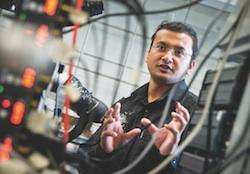Samarendra Mohanty, an assistant professor of physics, leads the Biophysics and Physiology Lab in the UT Arlington College of Science. Credit: UT Arlington
A new study by a University of Texas at Arlington physics team in collaboration with bioengineering and psychology researchers shows for the first time how a small area of the brain can be optically stimulated to control pain.
Samarendra Mohanty, an assistant professor of physics, leads the Biophysics and Physiology Lab in the UT Arlington College of Science. He is co-author on a paper published online Wednesday by the journal PLOS ONE.
Researchers found that by using specific frequency of light to modulate a very small region of the brain called the anterior cingulate cortex, or ACC, they could considerably lessen pain in laboratory mice. Existing electrode based ACC stimulation lacks specificity and leads to activation of both excitatory and inhibitory neurons.
"Our results clearly demonstrate, for the first time, that optogenetic stimulation of inhibitory neurons in ACC leads to decreased neuronal activity and a dramatic reduction of pain behavior," Mohanty said. "Moreover, we confirmed optical modulation of specific electrophysiological responses from different neuronal units in the thalamus part of the brain, in response to particular types of pain-stimuli."
The research focused on chemical irritants and mechanical pain, such as that experienced following a pinprick or pinch. Mohanty said the results could lead to increased understanding of pain pathways and strategies for managing chronic pain, which often leads to severe impairment of normal psychological and physical functions.
"While reducing the sensation for chronic pain by optical stimulation, we still want to sense certain types of pain because they tell us to move our hands or legs away from something that is too hot or that might otherwise hurt us if we get too close," Mohanty said.
Young-tae Kim, a UT Arlington associate professor of bioengineering and study co-author, said the research could "possibly lead to less invasive methods for treating more severe types of pain without losing important emotional, sensing and behavioral functions."
Ling Gu, a postdoctoral researcher who worked in the Mohanty lab, is lead author on the PLOS ONE paper, "Pain inhibition by Optogenetic Activation of Specific Anterior Cingulate Cortical Neurons." Other co-authors are Megan Uhelski, previous UT Arlington doctoral student in psychology, and Sanjay Anand, researchers in bioengineering; Mario Romero-Ortega, an associate professor of bioengineering at UT Dallas; and, Perry Fuchs, UT Arlington professor of psychology. The paper is available here: http://journals.plos.org/plosone/article?id=10.1371/journal.pone.0117746.
Recently, Mohanty's team demonstrated the first near-infrared laser based two-photon optical stimulation of in-depth brain regions. Read more at http://www.uta.edu/news/releases/2014/11/mohanty-papers.php. The team now plans to carry out localized non-invasive stimulation of small brain regions such as ACC to better understand and control functioning of brain.
Journal information: PLoS ONE
Provided by University of Texas at Arlington






















